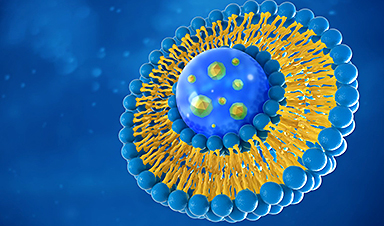Breakthrough medical technology like mRNA vaccines rely on tiny nanoparticles to deliver medicine to cells. A new device will help drug manufacturers and evaluators like the FDA more precisely measure genetic payloads to evaluate drug effectiveness.
An important component of the vaccines protecting people against SARS-CoV-2 virus and its variants are lipid nanoparticles, or LNPs. These circular particles carry therapeutic mRNA payloads, the snippets of genetic material that trigger our immune systems to defend against COVID-19. Even with their success, certain characteristics about the particles, such as payload distribution, are unknown. Researchers and the Food and Drug Administration want more insights about these characteristics to improve metrics reporting in pharmaceutical manufacturing.
A new molecular detection platform developed by two Whiting School of Engineering professors is answering the FDA’s call. Hai-Quan Mao and Tza-Huei (Jeff) Wang want to address how many mRNA molecules an LNP can carry and whether the mRNA is uniformly packed inside the particle to help researchers design more efficient and effective treatments and vaccines.
“Our platform processes molecules at the single nanoparticle level, but unlike the current imaging methods for mRNA LNPs, our approach is based on fluorescent spectroscopy and gives us the ability to see through the particles,” said Wang, a professor in the departments of Mechanical Engineering and Biomedical Engineering at the Whiting School, and a core researcher at the Institute for NanoBioTechnology.
The ability to peer inside the nanoparticles allows the researchers to differentiate between and measure empty LNPs that do not contain mRNA, LNPs with mRNA, and free-floating mRNA in a sample.
Their platform, called cylindrical illumination confocal spectroscopy, or CICS, works by tagging mRNA and LNP components with fluorescent signals of up to three colors and passing the sample through a detection plane. The detection plane reads the fluorescent signals and measures their intensity before comparing the strength of the intensities with that of a single mRNA molecule. The data analysis with an algorithm called deconvolution tells the team both how many mRNA copies are inside the LNP—if any—and their distribution in the sample. The team’s platform overcomes contrast limitations and increases the sample analysis throughput, that are seen in cryo-transmission electron microscopy, the current gold standard for imaging mRNA LNPs.
Tests conducted using this sensing platform revealed that from a benchmark solution of mRNA LNP used in academic research studies, over 50% of the LNPs are not loaded with mRNA molecules, and of the mRNA-filled LNPs, most of them contained two to three mRNA molecules per particle.
“Being able to quantitatively resolve payload characteristics of mRNA LNPs at the single particle level has never been done before. We are intrigued by the substantial presence of empty LNPs, and by altering formulation conditions, a single nanoparticle can load as few as one to as many as ten mRNA molecules.” said Mao, professor in the departments of Materials Science and Engineering and Biomedical Engineering at the Whiting School and director of the Institute for NanoBioTechnology.
The team’s results are published in Nature Communications.
“There are a lot of groups doing LNP research,” Wang said. “However, when they discover a formula that might work well, it has been hard to associate those discoveries back to the composition and payload distribution of the nanoparticles. With this platform we can provide a more comprehensive understanding on what is happening at the single particle level.”
More research is needed to learn how many mRNA molecules per LNP capsule is optimal for the most effective treatment. However, the empty LNPs revealed by the new platform show there is a need to improve methods for packaging the mRNA inside the LNPs.
Mao and Wang say that their platform shows that it has the potential to not only be used at all stages of LNP-related research and development, but also in the development of other drug delivery systems and quality control measures at the manufacturing stage. The team has filed a patent application covering the technique and is working with collaborators to use the platform to analyze other types of therapeutic cargos in diverse nanoparticle systems for treating different diseases.
“The FDA has recently addressed the need for better quality metrics in nanoparticle design in the pharmaceutical industry,” said Michael J. Mitchell, a leading scientist in the field of LNP research and Skirkanich Assistant Professor of Innovation in the Department of Bioengineering at the University of Pennsylvania. “This will become increasingly more important as mRNA LNP technology expands beyond vaccines into new therapeutics that are administered into the bloodstream, which have very stringent requirements. The new detection platform developed by Drs. Mao and Wang’s team is a potentially important step forward in addressing needs at the research and regulatory phase, and can potentially aid in the development of mRNA LNP technology beyond vaccines.”
News
Very low LDL-cholesterol correlates to fewer heart problems after stroke
Brigham and Women's Hospital's TIMI Study Group reports that in patients with prior ischemic stroke, very low achieved LDL-cholesterol correlated with fewer major adverse cardiovascular events and fewer recurrent strokes, without an apparent increase [...]
“Great Unified Microscope” Reveals Hidden Micro and Nano Worlds Inside Living Cells
University of Tokyo researchers have created a powerful new microscope that captures both forward- and back-scattered light at once, letting scientists see everything from large cell structures to tiny nanoscale particles in a single shot. Researchers [...]
Breakthrough Alzheimer’s Drug Has a Hidden Problem
Researchers in Japan found that although the Alzheimer’s drug lecanemab successfully removes amyloid plaques from the brain, it does not restore the brain’s waste-clearing system within the first few months of treatment. The study suggests that [...]
Concerning New Research Reveals Colon Cancer Is Skyrocketing in Adults Under 50
Colorectal cancer is striking younger adults at alarming rates, driven by lifestyle and genetic factors. Colorectal cancer (CRC) develops when abnormal cells grow uncontrollably in the colon or rectum, forming tumors that can eventually [...]
Scientists Discover a Natural, Non-Addictive Way To Block Pain That Could Replace Opioids
Scientists have discovered that the body can naturally dull pain through its own localized “benzodiazepine-like” peptides. A groundbreaking study led by a University of Leeds scientist has unveiled new insights into how the body manages pain, [...]
GLP-1 Drugs Like Ozempic Work, but New Research Reveals a Major Catch
Three new Cochrane reviews find evidence that GLP-1 drugs lead to clinically meaningful weight loss, though industry-funded studies raise concerns. Three new reviews from Cochrane have found that GLP-1 medications can lead to significant [...]
How a Palm-Sized Laser Could Change Medicine and Manufacturing
Researchers have developed an innovative and versatile system designed for a new generation of short-pulse lasers. Lasers that produce extremely short bursts of light are known for their remarkable precision, making them indispensable tools [...]
New nanoparticles stimulate the immune system to attack ovarian tumors
Cancer immunotherapy, which uses drugs that stimulate the body’s immune cells to attack tumors, is a promising approach to treating many types of cancer. However, it doesn’t work well for some tumors, including ovarian [...]
New Drug Kills Cancer 20,000x More Effectively With No Detectable Side Effects
By restructuring a common chemotherapy drug, scientists increased its potency by 20,000 times. In a significant step forward for cancer therapy, researchers at Northwestern University have redesigned the molecular structure of a well-known chemotherapy drug, greatly [...]
Lipid nanoparticles discovered that can deliver mRNA directly into heart muscle cells
Cardiovascular disease continues to be the leading cause of death worldwide. But advances in heart-failure therapeutics have stalled, largely due to the difficulty of delivering treatments at the cellular level. Now, a UC Berkeley-led [...]
The basic mechanisms of visual attention emerged over 500 million years ago, study suggests
The brain does not need its sophisticated cortex to interpret the visual world. A new study published in PLOS Biology demonstrates that a much older structure, the superior colliculus, contains the necessary circuitry to perform the [...]
AI Is Overheating. This New Technology Could Be the Fix
Engineers have developed a passive evaporative cooling membrane that dramatically improves heat removal for electronics and data centers Engineers at the University of California San Diego have created an innovative cooling system designed to greatly enhance [...]
New nanomedicine wipes out leukemia in animal study
In a promising advance for cancer treatment, Northwestern University scientists have re-engineered the molecular structure of a common chemotherapy drug, making it dramatically more soluble and effective and less toxic. In the new study, [...]
Mystery Solved: Scientists Find Cause for Unexplained, Deadly Diseases
A study reveals that a protein called RPA is essential for maintaining chromosome stability by stimulating telomerase. New findings from the University of Wisconsin-Madison suggest that problems with a key protein that helps preserve chromosome stability [...]
Nanotech Blocks Infection and Speed Up Chronic Wound Recovery
A new nanotech-based formulation using quercetin and omega-3 fatty acids shows promise in halting bacterial biofilms and boosting skin cell repair. Scientists have developed a nanotechnology-based treatment to fight bacterial biofilms in wound infections. The [...]
Researchers propose five key questions for effective adoption of AI in clinical practice
While Artificial Intelligence (AI) can be a powerful tool that physicians can use to help diagnose their patients and has great potential to improve accuracy, efficiency and patient safety, it has its drawbacks. It [...]





















